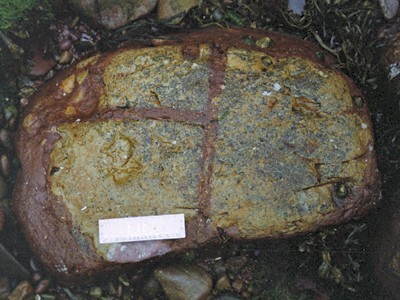Earth Science Conservation Review
| Cushendun - Bay Hotel to Cave House tunnel - Devonian | Antrim |
| Site Type: | Coastal section |
| Site Status: | ESCR |
| Council area: | Moyle District Council |
| Grid Reference: | D252327,D25253254 |
| Google maps: | 55.12614,-6.03731 |
| Rocks | |
|---|---|
| Rock Age: | Devonian (Lower Devonian) |
| Rock Name: | Cross Slieve Group, Cushendun Conglomerate |
| Rock Type: | Conglomerate, Sand, Sandstone |
| Interest | |
| Other interest: | cross-bedding |
Summary of site:
On the south side of Cushendun Bay, behind the old hotels, a road along a raised beach passes through a mostly natural tunnel to Cave House. The rocks forming the cliffs and pinnacles along this dramatic shoreline are carved from a spectacular pebble/cobble conglomerate. The pebbles range in size from 2 to 6cm, grading into cobbles, some exceeding 25cm in diameter. Almost all the pebbles and cobbles are of a pinkish-brown dense quartzite, presumed to be of ancient Dalradian origin but which cannot be matched in the area. The cobbles are heaped together and many have radiating fractures from their points of contact. The interstitial spaces are filled with a hard, reddish-brown sandstone and there are discontinuous beds of laminated red sandstones separating some conglomerates. They do not appear to result from a single event because some cobbles are clearly made up of finer, but similar pre-existing conglomerates. No fossils have been found in the Cushendun Formation but the rocks are known from their setting to be Devonian in age.
These rocks are considered to be desert conglomerates part of an alluvial fan (a conical mass of water-tumbled debris) heaped against the steep face of an upland area. The cobbles would have been swept along upland desert wadis by flash floods that then dropped their loads as they drained into desert lowlands.
There is also clear evidence of a higher sea level here during the last few thousand years because the sea cave floors, including the tunnel to Cave House, are now high and dry. The dynamics of marine cave erosion are also clear, each cave forming along a natural fracture, an obvious line of weakness.
These rocks are considered to be desert conglomerates part of an alluvial fan (a conical mass of water-tumbled debris) heaped against the steep face of an upland area. The cobbles would have been swept along upland desert wadis by flash floods that then dropped their loads as they drained into desert lowlands.
There is also clear evidence of a higher sea level here during the last few thousand years because the sea cave floors, including the tunnel to Cave House, are now high and dry. The dynamics of marine cave erosion are also clear, each cave forming along a natural fracture, an obvious line of weakness.
| Enlander, I., Dempster, M. & Doughty, P., 2025. Cushendun - Bay Hotel to Cave House tunnel - Devonian, County Antrim, site summary. [In] Earth Science Conservation Review. https://www.habitas.org.uk/escr/summary.php?item=307. Accessed on 2025-04-03 |
| Previous Site | Next Site |
